Sari Touching the Future
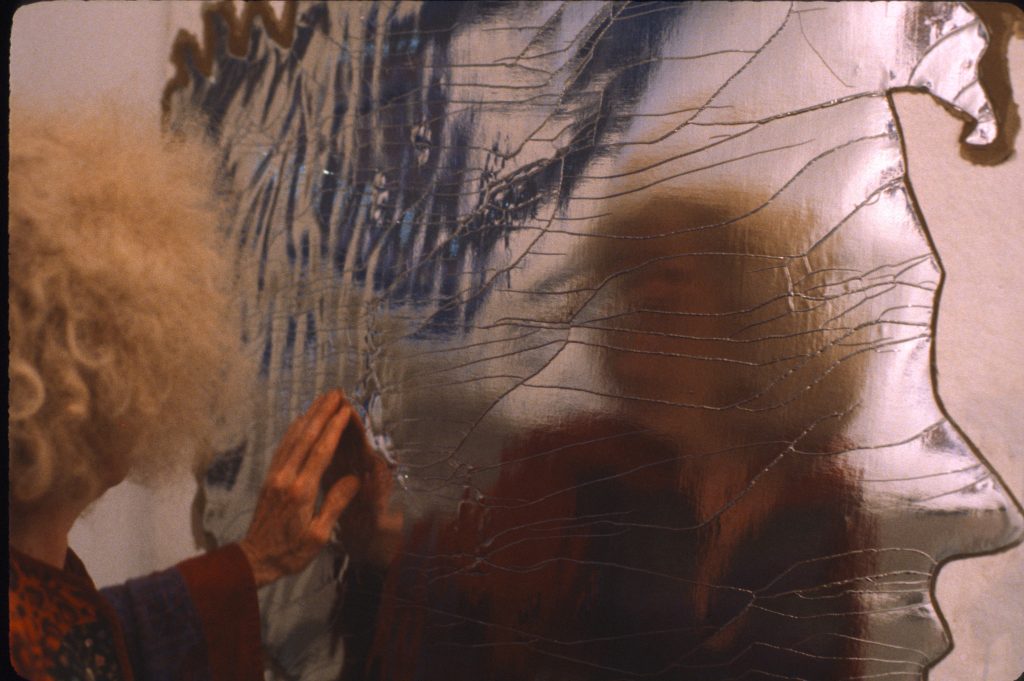
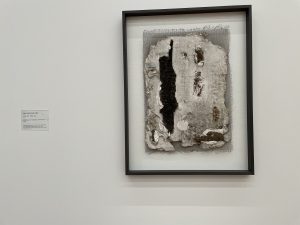
Screenbark by Sari Dienes c. 1953
Part of the Kunstmuseum Basel permanent collection, currently on display
https://kunstmuseumbasel-ch.translate.goog/de/sammlung/kunst-ab-1950?_x_tr_sl=de&_x_tr_tl=en&_x_tr_hl=en&_x_tr_pto=sc
https://www.museumspass.com/en/exhibition/fresh-window
For decades, there have been close links between the histories of art and shop window display. Besides Jean Tinguely, many other artists have designed pioneering window displays. Conversely, window displays frequently feature as a motif in artworks or serve as a stage for performances and actions. The exhibition will explore this eventful relationship from its beginnings to the present day, while artistic interventions in shop windows in Basel extend the show into public space.
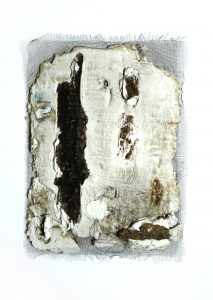
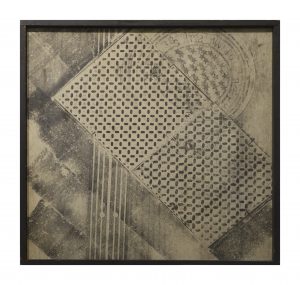
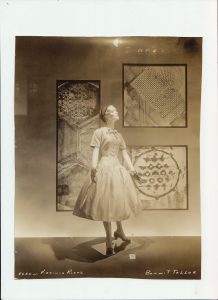
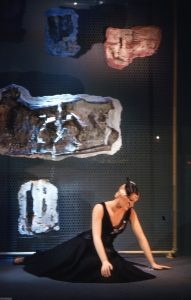
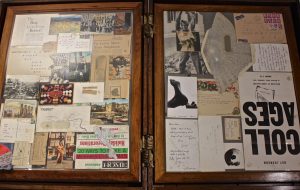
https://www.menil.org/exhibitions/380-fragments-of-memory
Fragments of Memory, a selection of works from the Menil’s permanent collection, explores the ways in which the past imbues the present. In their drawings, the featured artists take up commonplace embodiments of personal and collective memory, such as scrapbooks, snapshots, notes, relics, and odes, to reimagine how we might access fraught memories and contested histories. In the hands of these artists, such as Gael Stack, Luc Tuymans, Sari Dienes, among others with works on view in this exhibition, the past becomes replete with possibility, proposing new understandings of our present.
Memories are incomplete renditions of the past—composites built from slivers of recollections that reveal the emotions behind moments. The material form that memories take, such as bits of ephemera pressed into a scrapbook, can be similarly splintered. The drawings presented in this exhibition were created from the mid-20th century to the present moment and represent different ways that artists have placed fragments of personal experiences and historical events at the heart of their work.
Fragments of Memory is curated by Kelly Montana, Assistant Curator, Menil Drawing Institute.
1533 Sul Ross St.
Houston, TX 77006
713-525-9400
Wed–Sun 11am–7pm
Free Admission
© 2024
The Menil Collection
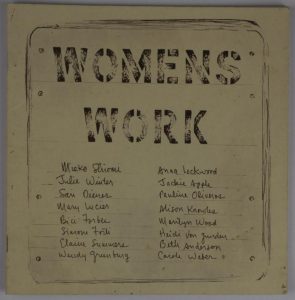
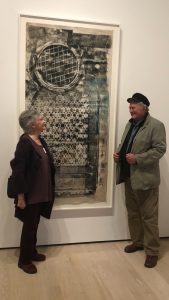
Sari Dienes Soho Sidewalk c. 1953
https://www.moma.org/calendar/galleries/5639
Join us to celebrate Sari Dienes’ Soho Sidewalk c. 1953 on view 4th floor 410.
Ongoing exhibition:
“These are scores ready for you to do.” This sentence introduces Womens Work, a 1975 publication highlighting experimental art by women artists. It was edited by the artist Alison Knowles and the musician Annea Lockwood, who reached out to friends and collaborators to submit language-based scores and instructions for readers to enact. Often emphasizing collectivity and cooperation, they ranged from improvised dance to writing “spatial poems” to creating theater and musical compositions.
Womens Work invoked the language of the second-wave feminist movement and its critique of the invisibility of labor performed by women. It aimed to bring attention to groundbreaking art produced by women, who were under-recognized both because of misogyny in the art world and because of their defiance of art conventions. This gallery features the titular publication and works by its contributors, which span music, dance, drawing, and performance.
Organized by Danielle Johnson, Curatorial Associate, Department of Drawings and Prints.
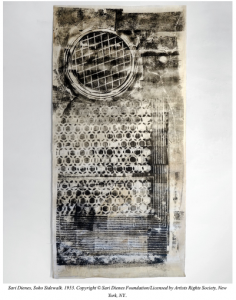
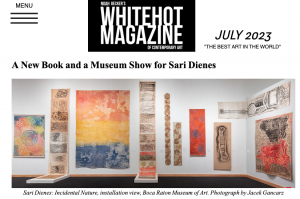
Mark Bloch’s article for White Hot Magazine features
“The Best Art In The World”
https://whitehotmagazine.com/articles/museum-show-for-sari-dienes/5895
Sari Dienes: Incidental Nature, installation view, Boca Raton Museum of Art. Photograph by Jacek Gancarz
Book Launch for Sari Dienes: Who I Am?!
Edited by Barbara Pollitt
Essays by Sid Sachs and Henry Martin. Text by Kate Zeller.
Published by Sari Dienes Foundation, 2023.
Sari Dienes: Incidental Nature
Boca Raton Museum of Art
June 14 – October 22, 2023
Curated by Kelli L. Bodle
By MARK BLOCH, July 2023 Sari Dienes was a sorceress who left important traces for today’s world of art. She operated from a tradition of magic but also of Modernism. She provided a link to the next generation, a gateway to the Postmodern, Asia and feminism. She was a model of independence, yet she embraced socialism, networking and communal living. A three year trip to Japan in the late ’50’s revealed that country’s cultural attraction to working in groups which was much to her liking. When Dienes returned to the US, she relocated to “The Land,” a collective community an hour north of Manhattan. She developed “rubbings,” the layering of surface textures to bring out, not the artist, but what is already present. “Art is humanity’s expressing… the understanding of reality,” she once said. What Nam June Paik, creator of the first video art, loved about her was, “the pure vitality of eternal spring (that).… the youngest generation is striving for.” Carolee Schneemann, an important early performance artist and maker of assemblages, said of her profound influence: “Sari prepares me certainly for Dada… aspects of European artists. She’s the bridge. She’s the threshold for me because no one else offers that.”
The career of Sari Dienes (1898-1992) spanned 60 years, an inspiring life story that catalogs the history of modern art from Paris and London in 1930 to the experiments of younger generations of artists in New York in the last decades of the century, until her death at age 93. She uniquely carried the torch from Cubism, Fernand Léger, Henry Moore, Duchamp and the Surrealists through the Abstract Expressionists and then onto post-war pre-Pop Neo-Dadas like Robert Rauschenberg, Jasper Johns and Ray Johnson and their followers, a next generation— the Fluxus artists, early performance artists who called their work Happenings, Events and Actions and early Feminists—women like Sari who just did it— Schneemann, Yoko Ono, Alison Knowles, and Charlotte Moorman. Each knew Sari well and was shaped by their association.
There is finally a book on the work and influence of Dienes, the boundary-breaking, unconventional 20th Century artist who worked with unconventional materials and ideas that were unclassifiable, often just out of the mainstream. Sari Dienes: Who I Am?! is a relatively slim volume but packed full and long overdue. It contains valuable information for today’s even younger art makers—who will also benefit by absorbing information about Sari Dienes’ life, work and legacy.
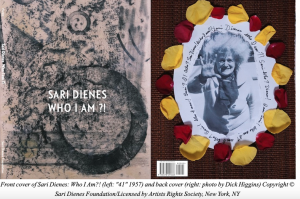
Front cover of Sari Dienes: Who I Am?! (left: “41” 1957) and back cover (right: photo by Dick Higgins) Copyright © Sari Dienes Foundation/Licensed by Artists Rights Society, New York, NY
The book makes up for its apparent thinness with an accompanying video—a multi-media expansion very much a part of who she was what she stood for— it brings her sound works, some lost pictures and many vibrant interviews to life—not only essential to her story but to question quandries we presently face. The book and video widen the window through which art appreciators of any age can experience the wild, strong force of nature that was Sari Dienes. Pointing a way forward through over-labelled muck that surrounds us, Dienes, unclassifiable in a world in which classification is, more than ever, only part of the story, shows us how to navigate the messiness and awkwardness of real life.
This definitive 112 page survey Sari Dienes: Who I Am?! was edited by Barbara Pollitt, one of the dedicated keepers of her legacy, with 175 illustrations and 144 comprehensive endnotes that make it an indispensable document for both scholars and strictly visual types looking to revel in the inspiring results and creative process of Dienes’ penetrating output. Her work and ideas also reach us via two essays. Sid Sachs, curator of the Philadelphia Art Alliance at University of the Arts, provides a thorough chronology with the assistance of scholar Kate Zeller. Then the late Henry Martin, author of several important, unorthodox books on Duchamp, Fluxist George Brecht and others, illuminates the spiritual quest behind Dienes’ endeavors. A film, Sari Dienes: A Life In Art, produced in 2021 by Pollitt with Adrian Hayman and Rip Hayman, two more essential preservers and curators of her vast archives, is linked through a QR code on Page 3 of the book.
The question mark in the book’s title focuses us on the open-ended, the impermanence and the unpredictable, ongoing works-in-progress for Dienes, for which her ideas and output are worthy symbols.
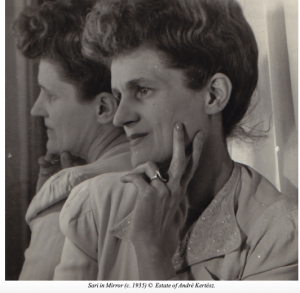
Sari in Mirror (c. 1935) © Estate of André Kertész.
I endorse a rethinking of Sari Dienes’ distinguished but dreamy position in the last 100 years of art, a radical moving up of her name to the top of the pantheon of important 20th century artists of which there were so many she personally knew. I propose we more readily accept the question marks she uniquely generated as givens of contemporary life that helped move the art-life continuum off the wall then and into the present. No artist’s work is a more deserving proxy for perplexing, persistent mysteries that, all these years later, still cry out to be addressed.
A recent book launch event for this new reference point in Dienes scholarship took place at an East Village locale, hosted by the Colloquium for Unpopular Culture at New York University. That department has been going strong since 2007 and seeks, in the words of the writer Rebecca Solnit, “to protect the obscure, the ineffable, the unmarketable, the unmanageable, the local, the poetic and the eccentric.” Given that quest, Dienes qualifies.
Sponsored by Sukhdev Sandhu, an NYU professor, the book signing, screening, and user-friendly gathering was held at the Center for the Humanities’ Institute For Public Knowledge, New York Institute for the Humanities, home to both the Hemispheric Institute of Performing and Policies and Artists Without Boundaries.
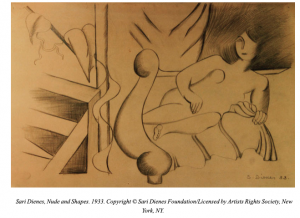
Sari Dienes, Nude and Shapes. 1933. Copyright © Sari Dienes Foundation/Licensed by Artists Rights Society, New York, NY.
Barbara Pollitt explained, “The culmination of the my 30 or so years of work with the Sari Dienes Foundation regarding the film and the companion book brings together the most accurate information on her life and work. The main writing in the book capture the timeline as well as the philosophy of her work. Many other colleagues and professionals are quoted in the book and the film. Exerpts and film interviews include John Cage, Carolee Schneemann, Rachel Rosenthal, Rip Hayman, Mark Hedden, and some 8 or 9 films including by PBS, Martha Edelheit, Dr. Mildred Pollner, Richard Raderman, Joan Guimmo and others.”
Professor Sandhu said of Pollitt and her subject Dienes: “Barbara’s tireless work in preserving Dienes’ art, researching her multitudinous life, and editing the first (and gorgeous) book dedicated to her—Sari Dienes Who I Am?!—is inspiring and worthy of celebration in its own right.” That is why a silent screening of the film providing background accompanied by a live talk by the book editor Pollitt and Rip Hayman, an important colleague to Dienes, were proceeded and followed by joy, food, conversation with some interesting show announcements and posters to peruse, including one about Dienes as an “innovator in a dozen art forms.”
That poster lists these art forms which make an excellent case for Dienes’ relevance today. She is hailed as a:
1 Xerox colorist
2 Assembler of Found Objects
3 Sound and Light artist
4 Preserver of Petroglyphs
5 Experimental Printmaker
6 Snow painter and earthworker
7 Conjurer of apparitions
8 Sculptor in glass mirrors, wood, mylar, etc
9 Clay collagist
10 Culinary artist
11 Unconventional portraitist
12 Dancer and poet
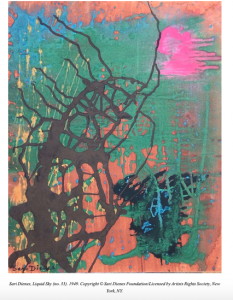
Sari Dienes, Liquid Sky (no. 33). 1949 Copyright © Sari Dienes Foundation/Licensed by Artists Rights Society, New York, NY.
Indeed, Sandhu also said, “Long before the likes of the Guerrilla Girls, she publicly protested against the lack of women artists in New York galleries,” and “she helped set up the avant-garde iteration of the Ear Inn and was beloved by artists such as Rauschenberg and Johns.” The Ear Inn is a bar on Spring Street that is still filled with her vibe.
The Boca Raton Museum of Art similarly credited her as “a mentor to Robert Rauschenberg and inspiration to Jasper Johns.” The Boca Museum is currently showing Incidental Nature, a show of Dienes’ work. Sandhu added, “She was everywhere and yet, especially since her death, she has been invisible.” But Rip Hayman, the director of the foundation that bears her name, who Dienes befriended fifty years ago, added with an accepting smile, “Never one to dwell on her past, she is still finding her place in the future.”
That is something we, as a living art community, can do: to place her, despite the dominance of money in the art worlds that find question marks so cumbersome; that that tell us that figures like Sari Dienes are unclassifiable, difficult, impossible to understand, never quite right. People like Sari Dienes upset the status quo and always have.
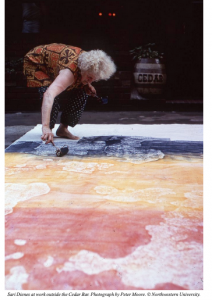
Sari Dienes at work outside the Cedar Bar. Photograph by Peter Moore. © Northwestern University.
Henry Martin’s text gives deep insights into Sari’s non-stop experimentation and how it fit with her mystical and philosophic motivations, most importantly her early attraction to Zen. Martin originally wrote his 1990 essay as the introduction to the catalogue of a touring European Dienes exhibition when she was still alive. He goes a long way toward helping the reader understand why magic and wonder are where life happens and what was at stake in an artist of the moment like Dienes. “I somehow connect that with the religious spirit,” said John Cage in an interview in the video about Dienes. “She—as I have too—became early involved with Oriental thought.”
The book’s title and a more left-brained approach comes from Sachs. His section provides a history of Dienes’ life. In the early 70s as a grad student at Rutgers studying with the the Fluxus artist Robert Watts, Sachs, manning the door at Onnasch Gallery in Soho met Sari, who incredulously inquired, “Don’t you know who I am?!!” She was shocked he didn’t—but he soon learned. The memorable halo of white hair and twinkle in Sari Dienes’ eye were vibrant and full of life and her message eclectic, anti-commercial and bemusing. Who indeed was she and if she was so important, why was she not packaged, monetized and branded?
The fact of the matter was that, even from an art market point of view, Dienes did everything right. She had four important shows at the Betty Parsons Gallery, an early promoter of the Abstract Expressionist movement. There were constant references to her and even cover stories in art magazines. Life Magazine did a feature on her. I first heard of Sari when a close friend of mine, Michael Heaton, wrote a feature on her that People Magazine was glad to do on her in the late ‘70s. Bill Moyers covered her innovations in his 1982 PBS television series Creativity. Dienes was not publicity-shy nor was the media out to marginalize her.
Yet, as Henry Martin wrote, “The explanation most often advanced is that Sari Dienes has simply done too much and worked in too many fields, thus denying her work an easy coherence or a simple recognizability… She has no trademark.” But as I suggest, that itself is a trademark worth discussing.

Sari Dienes, Soho Sidewalk. 1953. Copyright © Sari Dienes Foundation/Licensed by Artists Rights Society, New York, NY..
Sari Dienes did rubbings of rocks carved thousands of years ago that she regretted were not of maximum interest to the powers that be simply because scholars were not sure about their origins. She felt this rendered them less desirable or unsuitable for institutions who favor quantification despite her faithful documentation of their mystery, power and beauty. Similarly, she painted snow and built a stream of hubcaps in the wilderness. None of these were bad career moves but they were ahead of their time. Her documentation of the petroglyphs position her as an important model for how artists might make a difference at a time of creeping planetary disintegration.
Sari Dienes was born Sarolta Maria Anna Chylinska on October 8th, 1898 in Debreczen, Hungary. After gambling away the family’s fortune, her father made his living as a studio photographer. Her parents divorced when she was four years old. As a child Sari took piano lessons and studied dancing in Budapest with Valéria Dienes, the wife of a mathematician and poet, Paul Dienes, with whom Sari would eventually become romantically involved and marry in 1922.
Now the wife of an educator with two doctorates, Sari studied in Paris with Fernand Léger and Amédée Ozenfant, a French cubist painter and writer, at the Académie Moderne, and befriended the photographer André Kertész as well as the musician Bela Bartok, with whom she reconnected decades later in New York.
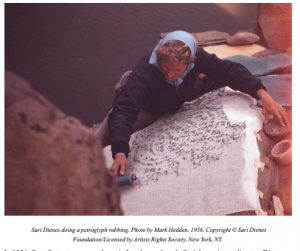
Sari Dienes doing a petroglyph rubbing. Photo by Mark Hedden. 1956. Copyright © Sari Dienes Foundation/Licensed by Artists Rights Society, New York, NY.
In 1936, Ozenfant set up an academy in London and made Sari the assistant director. Dienes would work with Ozenfant for the next 23 years at the Ozenfant Academy of Fine Arts. Dienes herself was responsible for recruiting Henry Moore for the staff of the school and she worked for a while under his guidance. When she introduced one of the school’s first students, Leonora Carrington, to a visiting teacher, Max Ernst, the former Dada, they become an important Surrealist couple.
Meanwhile in 1937, Sari separated from her husband Paul Dienes but kept his last name. Then in 1939, at Ozenfant’s request she sailed to Canada on the R.M.S. Montrose, arriving in Manhattan on September 3rd for a brief visit but unbeknownst to her, by the mid ‘50s she’d be an American citizen and remain a New Yorker for the rest of her life. Moving into an apartment at 77 Irving Place, she ran Ozenfant’s School in the US, remaining with him until 1941.
This was also period of “surrealistic fantasies” and Sari has stressed the importance of her interest in psychology. She took a studio at 18 W. 16th but moved uptown in 1945 because she needed more space. The Art Students League, a block away, was where she met the young Ray Johnson. As her work moved from Surrealism to Abstract Expressionist drips in 1945-46, she strayed from the internal angst of the New York School. Her outlook was upbeat.
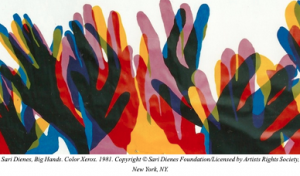
Sari Dienes, Big Hands. Color Xerox. 1981. Copyright © Sari Dienes Foundation/Licensed by Artists Rights Society, New York, NY.
She eventually met the Ab Ex crowd, including Jackson Pollock who once told her, “I hate you. I hate your work because I don’t think you can really be an artist without balls,” to which Dienes replied, “Jackson, that may be your problem, not mine.” But she said he later called her work at Betty Parsons’ “beautiful” and “wonderful.”
Holding her own in the world of macho painters, Sari befriended Mark Rothko and other abstractionists including Theodoros Stamos who, at the time, was one of the original “Irascibles” depicted in the famous photo. Stamos’ inspiration from Asian aesthetics and calligraphic brush strokes dovetailed with Sari’s own eventual interest in Zen. Surrealism’s automatic writing and psychology studies were rejuvenated in the mid-fifties by the mention of Zen in an Alan Watts book that changed her life.
Besides Johnson, Dienes had also befriended the composer Cage and choreographer Merce Cunningham. All three remained Dienes’ lifelong friends, even as they headed off to Black Mountain College, a hotbed of experimental (and Eastern) activity in North Carolina.
In 1947 Dienes took a three-month trip to Arizona, Colorado, New Mexico and Utah that altered her approach to art and life, exhibiting assemblages of found objects including driftwood and shells upon her return. In 1949 she made etchings and engravings at Stanley William Hayter’s Atelier 17 at the New School and showed them in group and solo shows at the Brooklyn Museum and New York galleries. She also showed prints with Louise Bourgeois and others in both New York and Philadelphia.

Sari Dienes, From Seed to Sky (detail from film stills). 1956. Copyright © Sari Dienes Foundation/Licensed by Artists Rights Society, New York, NY.
She taught a course in drawing and composition for the Brooklyn Museum Art School alongside Max Beckmann and William Baziotes and at her own studio until 1949. Then in 1950 Dienes was given the first of four important solo exhibitions at Betty Parsons Gallery. A second exhibition there showed her “Sidewalk Rubbings.” In August 1953 she famously quipped, “I took as my subject the streets of the city.” Dienes’ third solo exhibition featured a 66 foot long multimedia work displayed as a wandering labyrinth that has since been lost but portions of it are visible in the video. In her forth and final solo exhibition at Parsons’ gallery she exhibited clay collages and more rubbings.
James Britton, writing in San Diego/Point magazine in April 1957 hailed her not-yet-lost labyrinthian work, “From Seed to Sky” also known as “66,” as “her most amazing work to date.” He called it, “a painting 66 feet long (3 and 1/2 feet wide) which no eye, not even the artist’s, has ever seen all at once,” adding, “‘66’ functions on the level of music or poetry, since the senses cannot experience direct contact with all parts of the picture at a single sweep.” In ArtNews, Parker Tyler said of the show, “She makes it seem to disappear into the pictorial dimension so the collages make a kind of Magic Realism—but in reverse: the object is present—but seems unreal.”
Dienes undertook residencies at Yaddo, the MacDowell Colony, Cummington (Massachusetts) School of the Arts and The Research Studio in Florida and also traveled to Bozeman, Montana. During this time she began rubbings of natural materials and household objects, using a printer’s brayer and colored inks. It was at Cummington in the Berkshires that her daily walks through a graveyard eventually led to her intense focus on frottage—rubbings. The only other artist who embraced that discipline was Ernst but his technique was different.
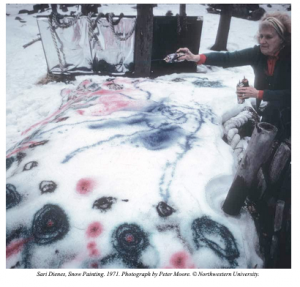
Sari Dienes, Snow Painting. 1971. Photograph by Peter Moore. © Northwestern University.
Back in New York and sometimes assisted by Cage, Johns, or Rachel Rosenthal, Dienes applied her techniques large and in the streets, often late at night, documenting manhole covers and subway gratings in an innovative series of large-scale works on paper because of the material’s readiness to respond to subtle detail.
The November 15th, 1954 issue of Life Magazine featured an article on her technique and two years later Craft Horizons featured an article on them by the important essayist and translator M.C. Richards, a friend who had also been part of Black Mountain College crowd.
Also in the mid-1950s, Dienes attended D.T. Suzuki’s weekly afternoon lectures on Zen Buddhism at Columbia University with Johnson, Cage, composers Earle Brown and Morton Feldman, poet Jackson Mac Low, Isamu Noguchi, and her gallerist, also a painter, Betty Parsons. The classes were often followed by soirées at Dienes’ 57th Street studio, where Johns befriended Cage and Rauschenberg in 1954 in another famous friendship with Dienes as catalyst.
Sari’s “Sidewalk Rubbings” and “Plaster Collages” were displayed in the windows of Bonwit Teller department store in 1956 in New York as Johns and Rauschenberg began their romantic and creative partnership as workers for the department store.
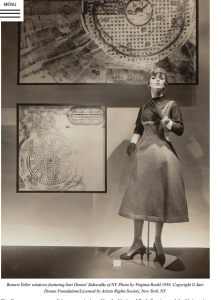
Bonwit Teller Windows: Sidewalks of NY. Photo by Virginia Roehl 1956. Copyright © Sari Dienes Foundation/Licensed by Artists Rights Society, New York, NY.
Finally, on a rescue expedition commissioned by the National Park Service and the University of Washington, Sari made rubbings of several hundred ancient Native American petroglyphs that were about to be submerged by the Dalles Dam in the Pacific Northwest. Dienes documented 350 surfaces before 48 were removed, capturing the mysterious imagery for posterity. She then traveled to San Francisco, where her petroglyph rubbings were displayed at the Palace of the Legion of Honor.
Perhaps as a result of the Suzuki lectures, Dienes next studied Japanese in preparation for a move to Japan from 1956 to ’58. On November 7, 1956, Ray Johnson wrote to Jiro Yoshihara, the founder of the Gutai Group with whom he was in correspondence, that a “famous artist will visit Japan soon. Her name is Sari Dienes.” Yoshihara didn’t replied to Johnson for two years due to illness “and the uncertain plans relative to the publication of the next issue of Gutai” but he eventually sent his regrets and we will never know what might have changed had Dienes been able to enter into a collaboration with the important Japanese performance-oriented group.
Returning to the US, in 1959, Dienes was included in the touring American Federation of Arts exhibition, Art and the Found Object with Rauschenberg, Duchamp, Joseph Cornell and Kurt Schwitters. With things rapidly changing in New York as the new generation came of age in the late 1950s, Sari’s “mirror constructions” became part of the important New Media, New Forms in Painting and Sculpture exhibition at the Martha Jackson Gallery. Then, at the Museum of Modern Art’s Art of Assemblage show, her bottle, mirror, wood, cork and foil, “Construction No. 11” adorned the catalogue.
These shows helped usher in both the Pop Art era and the use of the “event score” and “Intermedia” by Fluxus. Sari Dienes influenced the younger artists with her mere attendance at the premiere of poet Jackson MacLow’s composition A Piece for Sari Dienes, by MacLow, Joseph Byrd, Robert Dunn, Simone Forti, Toshi Ichiyanagi, La Monte Young and others at Yoko Ono’s Chambers Street loft in New York which was creating a new experimental field for Minimalism and other movements before they had names.
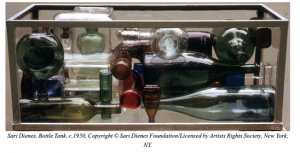
Sari Dienes, Bottle Tank. c.1950. Copyright © Sari Dienes Foundation/Licensed by Artists Rights Society, New York, NY.
In 1963, Dienes designed costumes for shows at the Judson Poets’ Theatre and sets for an Aristophanes work Congress of Women at the Cooper Union. She performed in an opera by Dick Higgins and Philip Corner at the Café Au Go Go. She collaborated with Ray Johnson and his imaginary Robin Gallery in a private “nothing” performance that was then publicized and distributed to his New York Correspondence School.
In May 1961 she moved to the Gate Hill Cooperative also known as “The Land,” a 116-acre community founded by Johnson’s Black Mountain College colleagues Paul and Vera Williams at Stony Point, New York, alongside the Minesceongo Creek where Dienes then lived for the rest of her life. Her neighbors included Cage, Richards, the musician David Tudor, and the filmmaker Stan VanDerBeek. She constructed an elaborate landscape of driftwood, glass and scrap metal around her house and collaborated with the environment to create art that lived in and utilized nature.
In 1962 her Mirror Collage #5 was included in the exhibition Contemporary Wall Sculpture at the Guggenheim Museum and her prints were featured in the exhibition Hayter and Atelier 17 at the Associated American Artists with works by Ernst, Pollock, Salvador Dalí, Alberto Giacometti and Joan Miró.
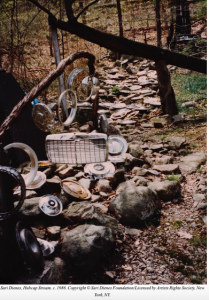
Sari Dienes, Hubcap Stream. c. 1986. Copyright © Sari Dienes Foundation/Licensed by Artists Rights Society, New York, NY.
In 1964, her mixed-media installation A Surrounding was featured at the Smolin Gallery and she designed sets and costumes for the Judson Poets’ Theatre. These “downtown” collaborations with younger artists continued for the rest of her life.
As she continued creating “bottle gardens” and exhibiting new petrograph rubbings, she created sets for a David Behrman performance at The Electric Circus on St. Mark’s Place in 1968. In 1969 she created a kinetic sound environment for Buckminster Fuller’s dome at the Festival dei Due Mondi in Spoleto, Italy. In 1970, the sculptor John Chamberlain cast her in an uncompleted film Zia, starring Warhol superstar Viva.
In 1971, Sari met Rip Hayman and Paco Underhill and moved in above the Ear Inn at 326 Spring Street in far west Soho and eight years later she bought the lease and operating license to the tavern. It became an important venue for art events including sound events, Fluxus dinners and in ‘78 a concert to mark Sari’s eightieth birthday.
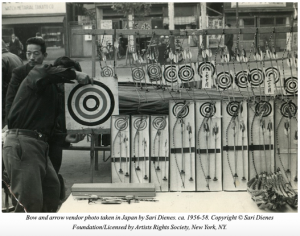
Bow and arrow vendor photo taken in Japan by Sari Dienes. ca. 1956-58. Copyright © Sari Dienes Foundation/Licensed by Artists Rights Society, New York, NY.
Dienes also contributed to the tenth, eleventh and twelfth Annual Avant Garde Festivals organized by Charlotte Moorman. She had proposed ‘Waffle Event’ using manhole covers as waffle irons in 1974. By 1977 a film about Sari had a premiere at the Museum of Modern Art, New York. In 1979 she contributed to Alison Knowles’s work The House of Dust at CalArts in Los Angeles and the Walker Art Center in Minneapolis. She also worked on Scrabble Chanting and Sole Dance with Jackson Mac Low and the S.E.M. Ensemble at the Albright-Knox Art Gallery in Buffalo. In 1990, the Italian Fluxus collector and impressario Francesco Conz published a suite of Sari’s prints.
Sari also spent the 1970s immersed in the new women’s movement in various forms. In 1973 she joined A.I.R., America’s first feminist cooperative gallery and exhibited there until the end of her life. Her first show was a melodic cascade of bones collected over a twenty-five-year period. In 1976 she was the recipient of an International Women’s Year Award and participated in a symposium Distinguished Women Artists, Their Past, Present & Future at the New School for Social Research and Women Artists Exhibiting in the Fifties at A.I.R. with Louise Bourgeois, Miriam Schapiro and others. In 1989 she was part of American Women Artists: The 20th Century at the Knoxville Museum of Art in Tennessee. During the 1970s Sari also began experimenting with color photocopies. In 1978 she showed in An Exhibition of Copy Machine Generated Art at the Hansen Galleries. In the late 70s Sari also continued undertaking residencies, fellowships and visiting lectures for various institutions including the National Endowment for the Arts.
In 1975 Sari traveled to India, Sri Lanka and Nepal. In 1984 she visited China. In ’77 she attended the opening of the Musée National d’Art Moderne at the Centre Georges Pompidou in Paris.
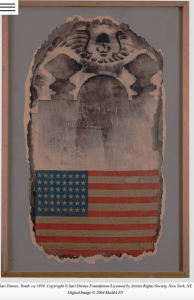
Sari Dienes, Tomb. ca 1954.. Copyright © Sari Dienes Foundation/Licensed by Artists Rights Society, New York, NY. Digital Image © 2004 MoMA NY
A 1976 show Recent Portraits of Sari Dienes at Buecker & Harpsichords in Soho featured portraits by Johnson, Higgins, Alice Neel, Robert De Niro Sr., Andy Warhol and others. It showed the high esteem in which so many New York artists held her. Throughout the 1980s, as before, Sari could often be found taking care of business and talking to customers at the Ear Inn.
In 1992 Sari died at her home at Stony Point, New York on May 25th. Before she did, Hungarian National Television, as part of their “Remarkable Hungarians” series, broadcast a documentary about her: Sari Dienes – Doyenne of the American Avant-Garde. Sarolta Maria Anna Chylinska had come full circle.
Schneeman said of Dienes and her work, “There was no explicit erotic body reference. There is no explicit gender definition. It had a universal assumption and in that regard it relates more to Fluxus where explicit self-depiction was considered incorrect. I don’t think that the Buddhist premise would judge anything so harshly but it relates to the rather harsh judgments of Fluxus in terms of explicit sexuality. But it also relates to Fluxus’s rather Zen sense of the permeation of presence and form and the vitality and life of the banal object when it’s regarded intensively. Like you pay attention and all these disciplines paying attention to what is is a necessity, if not a demand. But it’s a necessity and that’s where you build your great visual vocabulary. And your vocabulary of a psychic connection is through the life of ordinary elements and some are man-made and many keep going back to nature.”
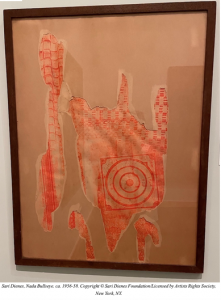
Sari Dienes, Nada Bullseye. ca. 1956-58. Copyright © Sari Dienes Foundation/Licensed by Artists Rights Society, New York, NY.
Henry Martin took it further, “the objects she meets in the world are… bearers of hidden and delicate messages. Martin weaves poignantly on the ideas and feelings behind the work, her trips to the southwest, her petroglyph rubbings and what they meant to her. “Her life and her work are one and the same thing,” he said, referring also to, “energies that flow beneath appearances” and a “sea of subtler forces.” Later, when she visually moved from the figurative to the abstract, he cited, “a shift to… states of pure psychic energy.”
Sari put it this way: “My definition of an artist is… just a human being—only more so.” She continued her experiments the rest of her life, always willing to invent anew as well as improvise on existing themes. She even did rubbings of Chico, Zeppo, Groucho and Harpo Marx’s footprints on Hollywood Boulevard. “There is nothing as serious as a joke,” she once told a friend of mine at the Ear Inn.
In the current Boca Raton show “the relational aspect of Dienes’s portraiture, rubbings, and homages are considered part of her technique. Known for hosting soirees and fostering relationships amongst the city’s many artists, Dienes was a venerable figure.”
The curator Kelli L. Bodle explains Sari’s reverence for both the social and the life of found objects as art: Dienes “took her materials out of the studio and into the streets, most times accompanied by a coterie of friends… to capture the texture and random patterns in the environment. Dienes’s interests weren’t restricted to only the artificial elements of the city streets but also the organic detritus like leaves, sticks, and even the pattern that blades of grass created.”
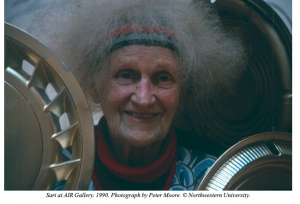
Sari at AIR Gallery. 1990. Photograph by Peter Moore. © Northwestern University.
Pollitt, the book’s editor and a caretaker of the Dienes Foundation said about the Boca show, “The installation of fifty of her rarely seen works underscores Sari’s important contribution,” adding, “It also reminds us of the importance of having Sari’s work available to be seen and studied in public collections… it a priority for museums to have the opportunity to acquire major works.”
Writing in ArtNews in 1972, Lawrence Campbell said, “Dienes has been an original talent for eons and anticipated almost everything Robert Rauschenberg ever did and possibly also Joseph Cornell—at least in terms of technique and experimentation.” Fifty plus years later, it is apparent that when she tackled American flags and targets concurrent with Jasper Johns and anticipated other art world trends, perhaps including even a few not yet invented, she was following what came naturally. Campbell concluded, “She’s also carried the art of frottage to hitherto undreamed of heights. She has even made a rubbing of Ray Johnson’s face.”
Indeed. A life-sized rubbing of Johnson’s entire body was part of recent show at David Zwirner. NYU’s Sandhu said of Dienes, “Her 57th Street loft was a meeting place for the likes of Twombly, Cage, Yoko Ono, Frank O’Hara and Rachel Rosenthal, many of whom she mentored and influenced.” It is an honor to say that though I never was at her home, I did see her occasionally at the Ear Inn and at events around the city. Like so many artists I have known, just like people yet to discover her, I am grateful for and inspired by the infectious spirit of Sari Dienes. And just for the record, her name is pronounced SHAR-EE DEENS. WH

Mark Bloch is a writer, performer, videographer and multi-media artist living in Manhattan. In 1978, this native Ohioan founded the Post(al) Art Network a.k.a. PAN. NYU’s Downtown Collection now houses an archive of many of Bloch’s papers including a vast collection of mail art and related ephemera. For three decades Bloch has done performance art in the USA and internationally. In addition to his work as a writer and fine artist, he has also worked as a graphic designer for ABCNews.com, The New York Times, Rolling Stone and elsewhere. He can be reached at bloch.mark@gmail.com and PO Box 1500 NYC 10009.
view all articles from this author
|
|||||||||||||||
|
Garner Art Center exhibition March 11-April 23
https://hudsonvalley.town.news/g/nanuet-ny/n/148119/lost-and-found-sari-dienes-art-no-limits-rediscovered
3-07-2023 8:09pm
Lost and Found: Rediscovering Sari Dienes’ Groundbreaking Artwork
Robert Brum Contributo
r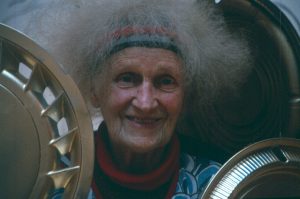
Sari Dienes. Photo by Peter Moore © Northwestern University
“Bones, lint, Styrofoam, banana skins, the squishes and squashes found on the street: nothing is so humble that it cannot be made into art.”
So spoke Sari Dienes, who spent 30 years creating mixed-media artwork at her Rockland County home from those and other humble objects.
Dubbed the “doyenne of the American avant-garde,” Sari (the S pronounced as in sugar) lived from 1961 until her death at age 92 at the Gate Hill Cooperative, known as “The Land,” off Willow Grove Road in the Town of Haverstraw.
There she was part of a community that included composers John Cage and David Tudor, choreographer Merce Cunningham, early music revivalist LaNoue Davenport, ceramicists Karen Karnes and M.C. Richards, and experimental filmmaker Stan VanDerBeek.
A descendant of Hungarian nobility, Dienes’ stature in the art world stretched back to the 1950s. She counted Jasper Johns, Robert Rauschenberg and Yoko Ono among her friends. In fact, Ono and husband John Lennon visited her at The Land in 1976 during one of the community’s legendary picnics.
A retrospective of Dienes’ groundbreaking work will be on exhibit March 11-April 23 at GARNER Arts Center, in the Harris Gallery of the Garnerville complex’s new Building 35 exhibition space.
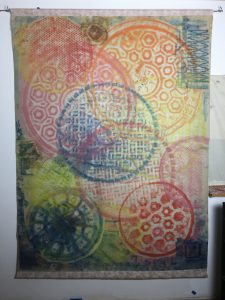
Manhole Wild II, 1955 street rubbing
Copyright © Sari Dienes Foundation/Licensed by Artists Rights Society, New York, NY.
The exhibit, comprising works from the Sari Dienes Foundation, includes prints from the 1950s through 1966, said Barbara Pollitt of Pomona, the foundation’s curator.
Pollitt describes Dienes’ art as “experimental and responsive. Sari, as a Zen Buddhist, believed that the human experience of art was very much a present response to what she called reality. She would do whatever she felt like without having any sense of limitation or hesitancy to experiment. She was quite sometimes a risk-taker in terms of actually using material.”
Dienes created prints using a roller called a printmaker’s brayer to lift ink impressions from sidewalk grates, manhole covers, pieces of wood, ancient rock carvings known as petroglyphs — anything with a textured surface, often juxtaposing the industrial design of manmade things with nature.
“This was part of Sari’s business, to see beauty in things that were seen to be discards. … Everything revealed some kind of artistic revelation, no matter what it was,” Pollitt said.
Pollitt met Dienes through her husband, composer Rip Hayman, who she said rescued the artist’s work at The Land after her death.
“We basically saved her 60-year career from the dumpster,” she said. “She didn’t have any family but she had a foundation. … We built a barn in our yard to house the collection, because Sari was impoverished.”
Dienes, whose work has been exhibited at MoMA and The Whitney, worked in a wide range of media, including painting, drawing, textile design, sculpture and ceramics over a career spanning more than 60 years. She co-owned the Ear Inn on Spring Street in lower Manhattan with Rip Hayman.
After the hurricane
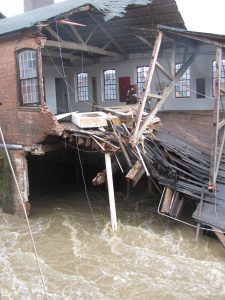
Photo of the 2011 GARNER Arts collapse during Hurricane
by Irene Cathy McErlean-Goddard.
The GARNER Arts exhibit is something of a rescue mission for Dienes’ legacy: A 2011 retrospective of her work was wrecked by Hurricane Irene, which flooded the center and ruined half the works on display — including Bone Fall, a cascade of bones she collected over a 25-year period.
“This is a big celebration,” Pollitt said. “This is a magnificent moment for the community.” She called GARNER’s Building 35 “just incredible. It is a state-of-the-art exhibition space.”
Pollitt, who edited a recently published book about Dienes titled, Who I Am?!, said Dienes was encouraging to aspiring artists, but carried with her “a sense of impoverished aristocracy” because of her background. Her grandmother was a baroness whose fortune was gambled away by Dienes’ father, according to the foundation.
“She always felt that she deserved more than she was getting, which was right, but it meant she had kind of a chip on her shoulder that was sometimes offensive to people,” Pollitt said.
Viewers of Dienes’ artwork are drawn in by her mysterious and surprising creative process, Pollitt said.
“Why is it that anything in this work that you could think of as a mistake looks like a purposeful stroke?” she posited.
Sari Dienes Exhibition
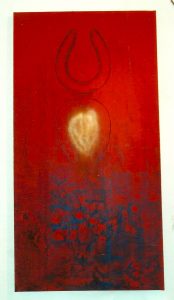
Seat of Joy, 1966 rubbing.
Copyright © Sari Dienes Foundation/Licensed by Artists Rights Society, New York, NY.
Related articles by this author:
Legend of ‘The Land’ lives on after more than six decades
Jasper Johns’ Stony Point Studio Rebranded as Guesthouse
Stay connected! Subscribe to free email updates from Hudson Valley News & Events
|

https://mailchi.mp/cf0e909d81f6/member-show-opens-this-weekend-242109?e=6d3aef9fb1
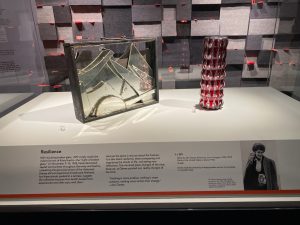 Sari’s work “I Spy/Traveling Kit” c. 1950 is being featured at this upcoming exhibition at the Corning Museum of Glass.
Sari’s work “I Spy/Traveling Kit” c. 1950 is being featured at this upcoming exhibition at the Corning Museum of Glass.
May 15, 2022 – January 8, 2023
More than 10 distinct vignettes will investigate how the Museum can broaden voices and narrative in our galleries. Generally, labels that accompany objects in museum galleries are written by museum curators and educators—and often focus on just one of an almost infinite number of possible stories and meanings. In this exhibition, objects—either alone or as a group—and their stories provide an entry point for further conversation.
Exhibition visitors will be introduced to the idea that the stories objects tell are always evolving. In fact, it is happening around them in the exhibition space. Visitors will be able to share their thoughts and add their ideas to the exhibition.
https://mamc-saint–etienne-fr.translate.goog/fr/expositions/house-dust?_x_tr_sl=fr&_x_tr_tl=en&_x_tr_hl=en&_x_tr_pto=sc
datesFrom November 19, 2022 to April 10, 2023
VenueMA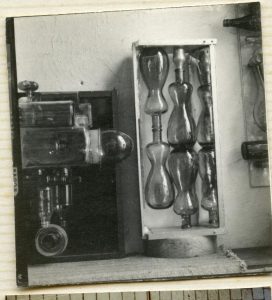 MC+
MC+
Echoing its programming attentive to female artists, the MAMC+ is offering a new display of collections aimed at improving the visibility of female creation, which represents only around 4% of its 20,000 works.
This exhibition borrows its title from a key work by Alison Knowles recently acquired by the Museum. American visual artist and poetess, co-founder of the Fluxus movement, Alison Knowles created The House of Dust in 1967 , a multimedia installation operating on the model of a performance, a reference work which constitutes one of the very first computer poems of art history. It stands at the crossroads of IT innovation, conceptual art — through its administrative aesthetics — and Fluxus.
The exhibition brings together some forty artists within a journey that intertwines generations (from the 1960s to today), nationalities and disciplines. The project benefits from a partnership with the Center National des Arts Plastiques, which is providing the loan of some fifty works for the occasion, the majority of which will join the Museum’s collection on deposit.
If this exhibition is based on the criterion of gender, it does not claim to essentialize female creation in art, but rather seeks to pursue the inclusive policy of the establishment, the rereading of its history and the discovery of its unknown or newly acquired funds. . This all-female journey, bringing together more than 130 works — paintings, installations, photographs, design, etc. — thus explores three main themes illustrating common and recurring concerns among these contemporary creators: language, body and matter.
Guided tours of the exhibition (from 15 years old) :
( In bold: the works of these artists belong to the collections of the CNAP – National Center for Plastic Arts – and are on loan to the MAMC+):
Magdalena Abakanowicz , Marina Abramović, Laurie Anderson, Eleanor Antin, Geneviève Asse, Anna-Eva Bergman, Louise Bourgeois, Lisetta Carmi, Sarah Charlesworth , Marieta Chirulescu, Marinette Cueco , Sari Dienes , Thea Djordjadze, Nathalie Du Pasquier , Gloria Friedmann, Shirley Goldfarb , Nan Goldin, Jan Groover, Guerrilla Girls, Sheila Hicks , Jenny Holzer, Dorothy Ianonne, Kimsooja, Karen Knorr, Alison Knowles, Barbara Kruger, Laura Lamiel , Helen Levitt, Annette Messager, Tania Mouraud, Gina Pane , Sheila Reid, Takako Saito , Valentine Schlegel, Cindy Sherman, Kiki Smith, Jessica Stockholder, Nathalie Talec, Tatiana Trouvé, Jackie Winsor

Alexandre Quoi
Head of the MAMC+ scientific department
A publication will be published in the “Collection of collections” series which promotes different collections highlighted in the context of the annual MAMC+ exhibitions.
nearly 40 artists
more than 130 works
MUSEUM COLLECTIONS & CNAP LOANS
1960 – 2020

Dates
https://www.kunstverein-wiesbaden.de/en/event/opening-fluxus-sex-ties-hier-spielt-die-musik
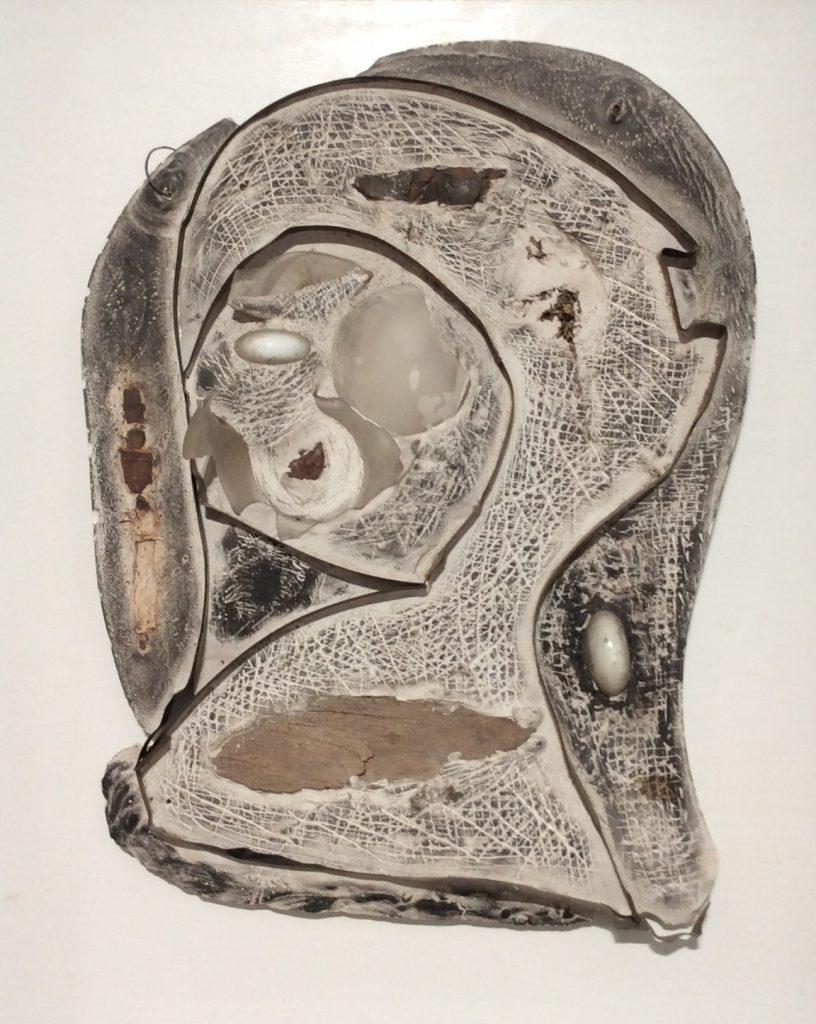
JUNE 11–JULY 30, 2022
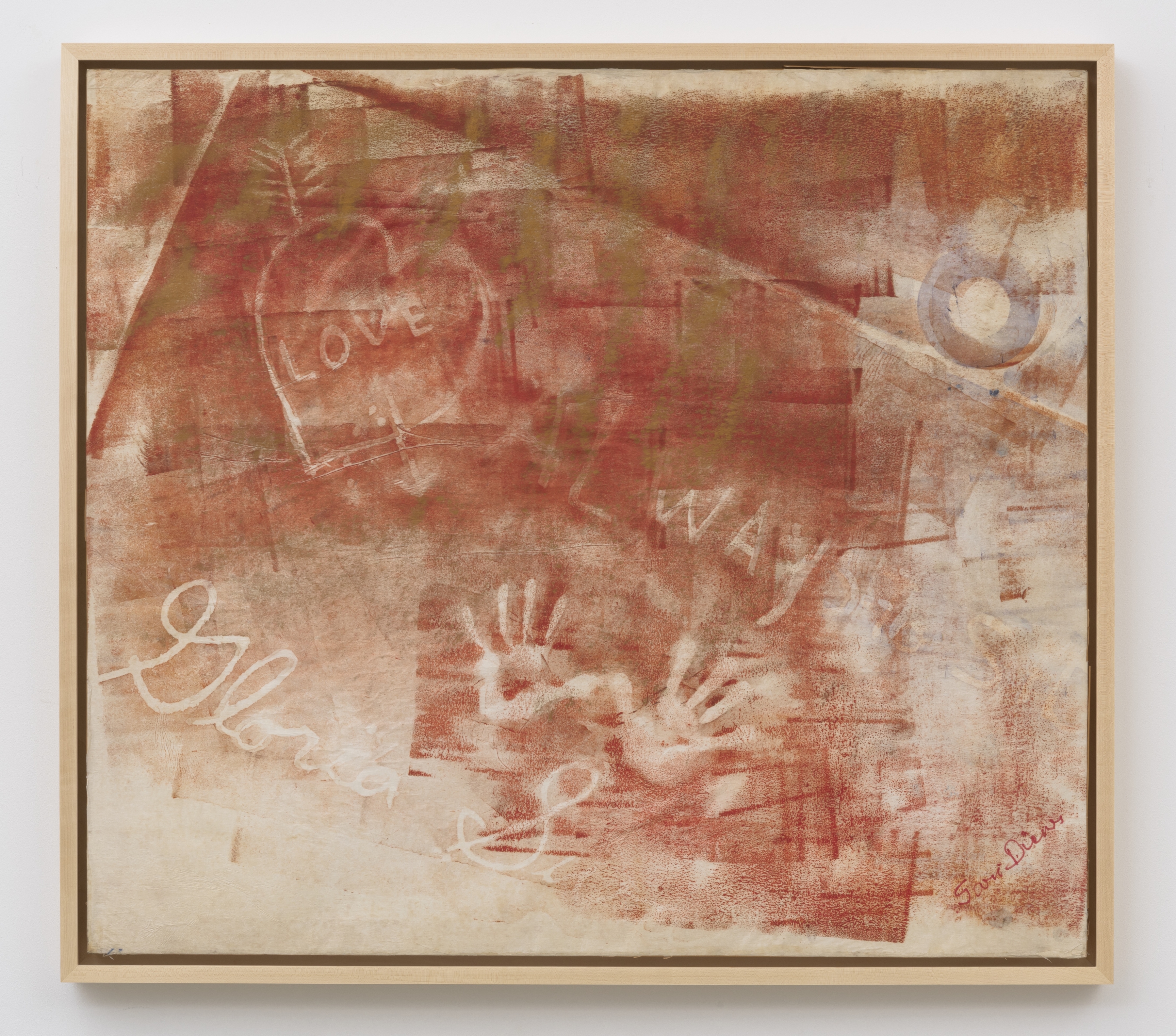
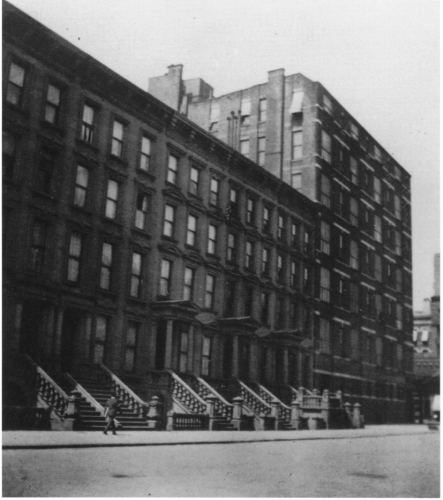
Sherwood Studio Building, 58 West 57th Street. Photo c.1902-03.
McClain Gallery presents two simultaneous solo exhibitions of historic works by Sari Dienes (1898–1992) and Addie Herder (1920–2009).
Dienes and Herder’s distinctive creative paths overlapped in the storied Sherwood Studios during the 1950s and 1960s. Sherwood Studios at 58 West 57th Street, New York, NY was built as a home to artists and writers in the nineteenth century and remained active until 1960. Both artists were adventurous in their approach to material experimentation, incorporating found objects in a way that exposed their keen awareness of the urban environment they inhabited. We are grateful to Pavel Zoubok Fine Art for their collaboration on these exhibitions.
SARI DIENES
During a career that spanned over six decades, Sari Dienes worked in a wide range of media, creating paintings, drawings, prints, sculptures, ceramics, textile designs, sets and costumes for theater and dance, sound-art installations, mixed-media environments, music, and performance art. This exhibition focuses on Dienes’ work from the early 1950s and traces her evolution through the 1960s when she rejected her formal training to begin experimenting with new materials and techniques. The shift in her practice from painting and drawing towards “rubbings,” layering urban textures of
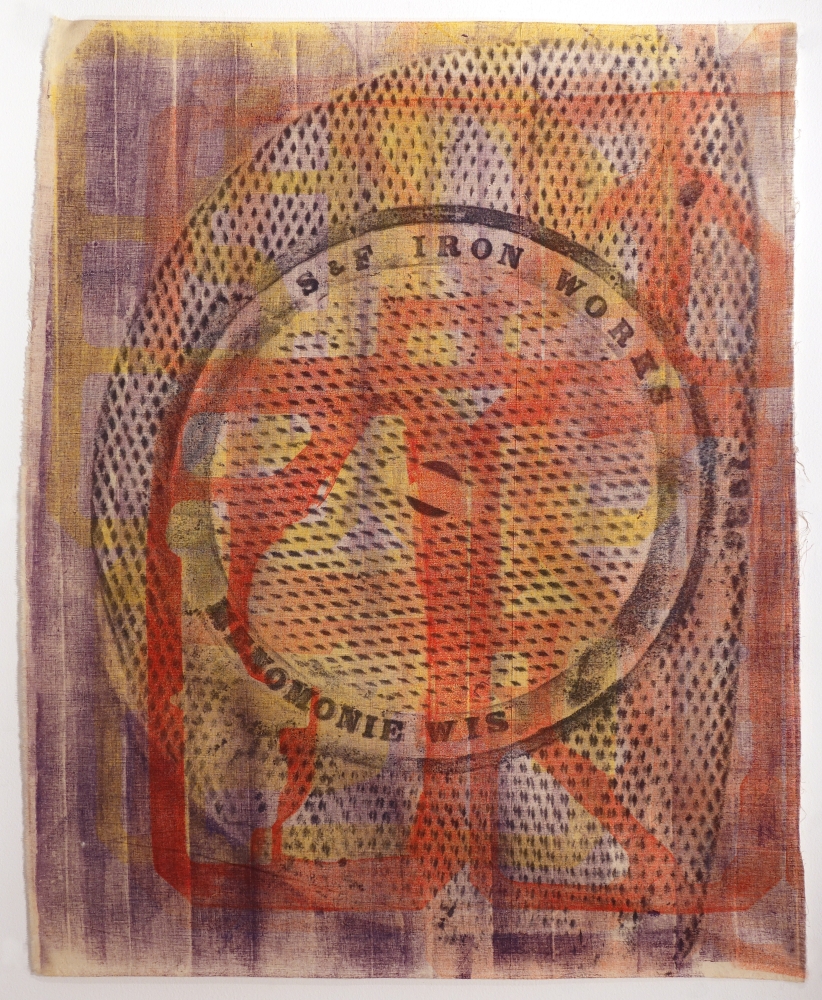
Sari Dienes, Menomonie 7, c. 1966, rubbing on fabric, 35 x 28 inches
manhole covers and sidewalks and assemblages of found objects into all-over abstraction can be firmly located in the Sherwood Studios. Upon taking up residency there in 1945, Dienes met and began a lifelong friendship with composer John Cage and choreographer Merce Cunningham. She quickly established herself in the epicenter of the art world during the 1950s, influencing artists such as Robert Rauschenberg, Jasper Johns, Mark Rothko, and Ray Johnson. Though widely exhibited during her lifetime, Dienes’ legacy is dominated by her powerful monoprints of subway grates and manhole covers. This exhibition articulates a formal sensibility that permeated all she created, tracking the development of her body of work through exuberant explorations in frottage, collage, and assemblage.
Dienes was born in Debreczen, Hungary, in 1898. From 1928–1935, she moved to Paris and then London where she studied with Fernand Léger, Amédée Ozenfant, André Lhote, and Henry Moore. In 1939, Dienes relocated to New York, where she would remain until her death.
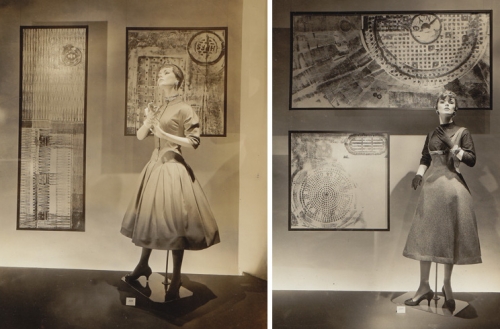
Sari Dienes’ Sidewalk Rubbings in Bonwit Teller windows, New York, 1955 – photos Virginia Roehl
Dienes exhibited nationally and internationally from the early 1940s, with notable exhibitions at Betty Parsons Gallery in New York City and later as a founding member of the Feminist collective, A.I.R. Gallery in Brooklyn, New York. Her work has been included in major museum exhibitions, including the Museum of Modern Art, New York, New York; the Solomon R. Guggenheim Museum, New York, New York; the Brooklyn Museum of Art, Brooklyn, New York; The Art Institute of Chicago, Chicago, Illinois; the Rhode Island School of Design, Providence, Rhode Island; the Museum of Fine Arts Boston, Boston, Massachusetts; and the Wadsworth Atheneum, Hartford, Connecticut. Recent exhibitions at The Hammer Museum, Los Angeles, California; The Menil Collection, Houston, Texas; The Drawing Center, New York, New York; Pavel Zoubok Gallery, New York, New York; Marc Selwyn Fine Art, Beverly Hills, California; the Philadelphia Art Alliance at University of the Arts, Philadelphia, Pennsylvania; and McClain Gallery, Houston, Texas as well as new scholarship on her work have renewed interest in her life and work. Visit the Sari Dienes Foundation website for a narrative timeline.
“Armed with an ink roller, she mapped her urban haunts as well as her body’s movement; uneven and ghostly skeins of pigment document her repetitive application of a standard-size brayer across the surface. Dienes placed drawing at the center of her practice while simultaneously challenging traditionally held views about the medium.”
–text excerpt from Sari Dienes’ 2014 solo exhibition at The Drawing Center, NYC, New York.
SARI DIENES
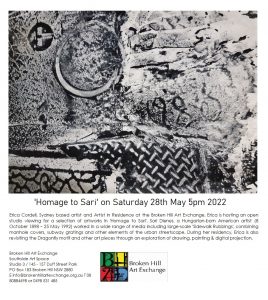
Presented at The Broken Hill Art Exchange in outback N.S.W Australia.
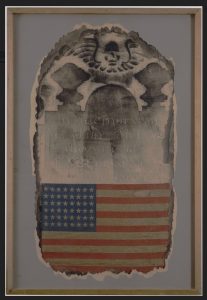 https://mailchi.mp/pavelzoubok/upcoming-program-and-gallery-artist-news-4771898?e=cb1ff62ada
https://mailchi.mp/pavelzoubok/upcoming-program-and-gallery-artist-news-4771898?e=cb1ff62ada